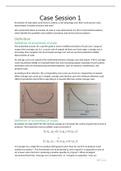Case Session 1
Economies of Scale allow some firms to achieve a cost advantage over their rivals and are a key
determinant of market structure and entry.
We mostly think about economies of scale as a key determinant of a firm’s horizontal boundaries,
which identify the quantities and varieties of products and services that it produces.
Definition
Definition of economies of scale
The production process for a specific good or service exhibits economies of scale over a range of
output when average cost (i.e., cost per unit of output) declines over that range. I average cost is
increasing, then marginal cost must exceed average cost, and we say that production exhibits
diseconomies of scale.
An average cost curve captures the relationship between average costs and output. A firm’s average
costs may decline initially as it spreads fixed costs over increasing output. Examples of such volume-
insensitive costs are manufacturing overhead expenses, such as insurance, maintenance, and
property taxes.
According to Jhon Johnston, the corresponding cost curves are closer to L-shaped than U-shaped.
When average cost curves are L-shaped, average costs declines up to the minimum efficiency scale
(MES) of production and all firms operating at or beyond MES have similar average costs.
Definition of economies of scope
Economies of scope exist if the firm archives savings as it increases the variety of good and services it
produces. The production process exhibits scope economies if:
TC ( Q x , Q y ) <TC ( 0 ,Q y ) + TC(Q x , 0)
TC ( Q x , Q y ) −TC ( 0 , Q y ) <TC( Q x , 0)
It is cheaper for a single firm to produce both goods X and Y than for one firm to produce X and
another to produce Y. The incremental cost of producing Q x units of good X, as opposed to none at
all, is lower when the firm is producing a positive quantity Q y of good Y. When strategists
recommend that firms “leverage core competencies” or “compete on capacities,” they are
1|Page
, essentially recommending that firms exploit scope economies. It is thus important to identify specific
sources of scale economies and if possible, measure their magnitude.
Scale economies, Indivisibilities, and the spreading of
Fixed Costs
The most common source of economies of scale is the spreading of fixed costs over ever-greater
volume of output. Fixed costs arise when there are invisibilities in the production process. Invisibility
simply means that an input cannot be scaled down below a certain minimum size, even when the
level of output is very small.
Economies of scale due to spreading of product-specific fixed costs
Examples of Fixed costs:
Product-specific fixed costs may include special equipment such as the cost to manufacture
a special die used to make an aircraft fuselage.
Fixed costs may also include R&D such as the cost of developing graphics software to
facilitate development of a new video game.
Fixed costs may include training expenses such as the cost of a one-week training program
preceding the implementation of a total quality management initiative.
Fixed costs may also include setup costs such as the time and expense required to design a
retailer Web page.
The average fixed cost of operating for 1 year is determined by dividing the annual cost by total
output.
Economies of scale due to trade-offs among alternative
technologies.
The fully automated technology described previously may yield the greatest cost savings when used
to capacity, but it may not be the best choice at lower production levels. There may be an alternative
that requires less initial investment, albeit with a greater reliance on ongoing expenses.
If a firm has to choose between a fully automated technology (superior, but more expansive) or a
not-fully automated technology (less expansive, but les superior). Then it can be that the FAT is only
optimal at high production levels, and it is more costly at lower production level.
Reduction in average costs due to increase in capacity utilization are short-run economies of scale in
that they occur within a plant of a given size. Reduction due to adaption of technology that has high
fixed costs but lower variable costs are long-run economies of scale.
The long-run average cost curve is everywhere on or below each short-run average cost curve. This
reflects the flexibility that firms have to adopt the technology that is most appropriate for their
forecasted output. Regardless of plant size, firms that plan on exploiting scale economies must
achieve the necessary throughput.
Indivisibilities are more likely when production is capital intensive
When the costs of production capital such as factories and assembly lines represent a significant
percentage of total costs, we say that the production is capital intensive. When most production
expenses go to raw materials or labor, we say that production is materials or labor intensive.
Because materials and labor are divisible, they usually change in rough proportion to changes in
output, assessing the importance of scale economies.
2|Page





